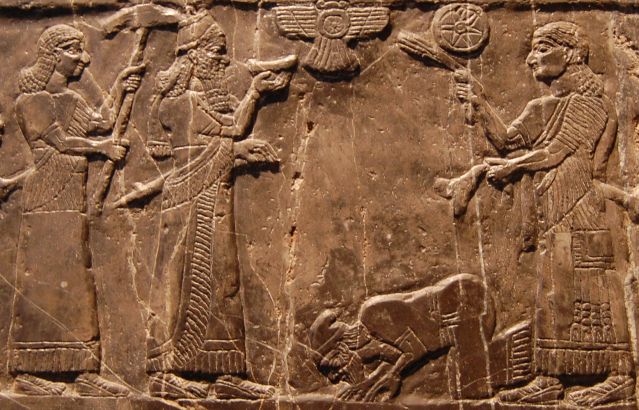Body Language
A Brief History of Submission
Look to ancient history and animal behavior to learn when and how to kowtow.
Updated September 6, 2024 Reviewed by Kaja Perina
Key points
- Egyptian subjects prostrated themselves to pharaohs thousands of years ago.
- Proskynesis, the act of bowing down before a ruler, was common in Mesopotamia and India and China.
- Kowtowers to Chinese emperors knocked their heads on the ground nine times.

It was rdj Hr-Xt, or going down on your belly, in Egyptian hieroglyphics; in Greek it was προσκύνησις, or proskynesis; Latins called it adōrātiō, adoration; in Sanskrit it was प्रणाम, or praṇāma, or prostration; it was 叩头, or kòutóu, or kowtow in Chinese.
In the middle of the Middle Kingdom in Egypt, almost 4,000 years ago, a civil servant, Sinuhe, came home to his pharaoh, Senusret I. “I found his majesty on the great throne in the portal of electrum. Then I was stretched out prostrate, unconscious of myself in front of him, while this god was addressing me amicably. I was like a man seized in the dusk, my soul had perished, my limbs failed, my heart was not in my body. I did not know life from death.” So his pharaoh said: “Get up.”
Submission can be associated with a number of emotions. Shame, envy, admiration, respect, contempt, anger and fear are involved. Pride is generally associated with dominance, and with a "heads up" stance. Signs of submission usually involve heads and bodies down.
In the Gilgamesh epic, parts of which probably go back to the 27th century BCE, an Ancient Near Eastern king struts his power like a bull and takes brides away from their grooms. “He will have intercourse with the destined wife, he first, the husband afterward.” But he runs in with Enkidu, the wild ass of a man who wins his people over. “The men were clustered about him, and kissed his feet as if her were a little baby.”
Much later, in the middle of the 1st millennium BCE, Herodotus of Halicarnassus wrote about προσκύνησις or proskýnēsis, or proskynesis, in his Histories. He knew it was an old Persian habit, and he didin’t like it. “Instead of greeting by words, they kiss each other on the mouth; but if one of them is inferior to the other, they kiss one another on the cheeks, and if one is of much less noble rank than the other, he falls down before him and worships him.” Isocrates, the Athenian who lived a few decades later, felt pretty much the same way. “Because they are subject to one man's power, they keep their souls in a state of abject and cringing fear, parading themselves at the door of the royal palace, prostrating themselves.”
Roman emperors, who followed a long republican precedent, absolved their subjects of proskynesis for hundreds of years. But toward the end of the 3rd century, Diocletian insisted on it. “He was the first that introduced into the Roman Empire a ceremony suited rather to royal usages than to Roman liberty, giving orders that he should be adored.” A little more than a century later, Constantine the Great moved the capital from the Latin West to the Greek East, adopted some local customs, and told the senate to get down. So did the emperors who came after him. Both Justinian, the lawgiver, and Theodora, the girl he took out of the stews and put up in the palace, liked obeisant subjects. “All members of the senate and those as well who held the rank of patricians, whenever they entered into their presence, would prostrate themselves to the floor, flat on their faces, and holding their hands and feet stretched far out they would touch with their lips one foot of each before rising.”
Kowtowing had gone on for millennia in Asia by then. In the wake of Alexander the Great’s invasion of India in 327 BCE, Chandragupta Maurya brought the Indus and Ganges together under one yoke. Not long afterward Chandragupta’s prime minister, Kautilya, wrote this in his Arthashastra, or treatise on government: “The life of a man in the service of an emperor is aptly compared to a life in fire. Fire may burn part of or the whole body, but the emperor has the power to advance or destroy his whole family.”
Kowtowing is older in China. People have been knocking their heads on floors for the benefit of their betters since the Zhou Li, or Rites of Zhou, a dynasty that began in the 11th century BCE. Those rites elaborate on 9 degrees of kowtow; the grand kowtow, reserved for an emperor, involved kneeling 3 times with touching the head to the ground 9 times. And kowtowing had staying power. In 1793, the Hanoverian king of England, George IIII--who'd just lost a war with his North American colonies, and may in the end have lost his mind--got a letter from the Qing emperor, Qianlong. George was reassured: “If you assert that your reverence for Our Celestial dynasty fills you with a desire to acquire our civilization, our ceremonies and code of laws differ so completely from your own that, even if your Envoy were able to acquire the rudiments of our civilization, you could not possibly transplant our manners and customs to your alien soil.” The British ambassador did as he pleased.
Other animals know how to kowtow. To vespologists, it’s "akinesis," involving a bent head, legs, and antennae; to mammalogists, it’s "tetany," another sort of paralysis.
Naked mole rats are small, subterranean rodents native to the Horn of Africa, who live in societies of tens or hundreds of workers, with a single breeding queen. She grows up to twice workers’ size, and demands deference from them. They’re hissed at and shoved; they double up on their backs with their bodies contorted and their feet in their air. That sort of involuntary muscle spasm, or “tetany,” lasts long after the queen has disappeared.
Bugs kowtow too. Paper wasps live all over the world on pulpy little nests made of regurgitated plants. Queens use their antennae to tap dozens of helpers on their heads, abdomens, thoraxes, and eyes; and the usual response is paralysis, or “akinesis:” workers contort their heads, antennae and legs, and are unable to move.
Other animals submit otherwise. Veiled chameleons change color; fallow deer avert their antlers; wolves lower their ears.
And daffodil cichlids submit, oddly enough, "heads up." Also known as the princesses of Zambia, these fish are native to Lake Tanganyika, where pairs of dominants breed in underwater caves, then 1-14 subordinates feed and defend their broods. Oddly enough, when dominants approach, they put their heads down in this case, and subordinates rise up--exposing their vulnerable throats. In crowded environments, indicators of deference increase. To paraphrase the ichthyologists who study these animals, "Submission signals are less common when more shelters to flee to are available."
Across species, subordinates respond to dominants in a couple of ways. One is to go low. The other is to get lost.
Kowtow when you can’t get out.
Kowtow when you don’t have a choice.
ACCOMPANIMENT: https://www.youtube.com/watch?v=wC10VWDTzmU
References
Abe, T. (2018). Proskynēsis: From a Persian Court Protocol to a Greek Religious Practice. Tekmeria, 14, 1-45.
Fu, Z. (1991). Continuities of Chinese political tradition. Studies in Comparative Communism, 24, 259-279.
Pardi, L. (1948). Dominance order in Polistes wasps. Physiological Zoölogy, 21, 1-13.
Parkinson, R. B. (2024). The Life of Sinuhe: A Reader’s commentary to the Middle Kingdom Version(s). Hamburg: Widmaier Verlag, in press.
Redden, A. R., Ruberto, T. and Reader, S. M. (2022). Submission signals in animal groups. Behaviour, 159, 1-20.
Sherman, P., Jarvis, J, and Alexander, R. (1991). The Biology of the Naked Mole-Rat. Princeton: Princeton University Press.
Al-Shawaf, A. and Shackelford, T. (2024). The Oxford Handbook of Evolution and the Emotions. New York: Oxford University Press.
Ruberto, T., Swaney, W. T. and Reddon, A. R. (2024). Submissive behavior is affected by territory structure in a social fish. Current Zoology, zoae014.




